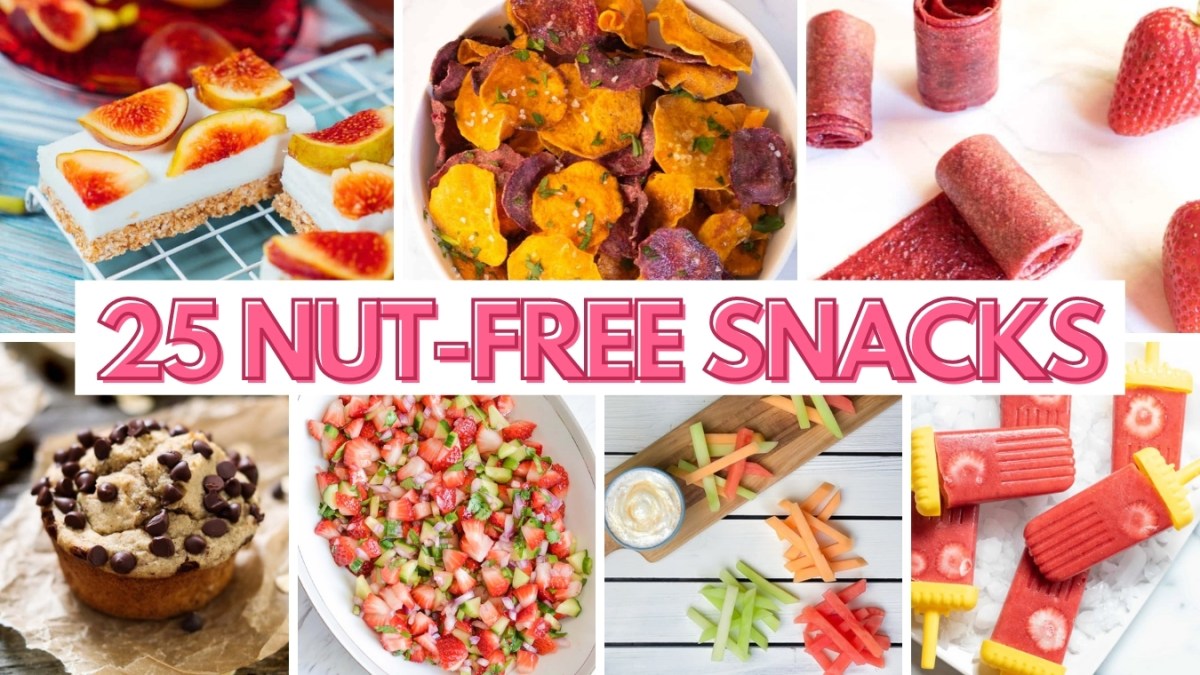Navigating the world of snacks can be a minefield, especially for those with nut allergies or seeking budget-friendly options. Imagine a vibrant spread of delicious, allergy-safe treats, each bursting with flavor and nutrition, without breaking the bank. This guide unveils a treasure trove of affordable nut-free snack ideas, from quick recipes ready in minutes to savvy shopping strategies that maximize your budget. We’ll explore creative ways to transform simple ingredients into satisfying snacks, perfect for lunchboxes, after-school treats, or anytime cravings strike.
We’ll delve into detailed, easy-to-follow recipes, showcasing the cost-effectiveness of homemade snacks compared to store-bought alternatives. Learn how to adapt your favorite recipes to be nut-free, discovering clever substitutions and techniques that preserve both taste and nutritional value. Discover budget-friendly shopping tips, including utilizing coupons, buying in bulk, and choosing smart store brands. This comprehensive guide equips you with the knowledge and inspiration to create a delicious and affordable nut-free snacking experience.
Shopping Strategies for Affordable Nut-Free Snacks
Finding delicious and nutritious nut-free snacks without breaking the bank is entirely achievable with a little planning and smart shopping. This section will explore strategies to maximize your snack budget while maintaining a healthy and varied diet.
Grocery Store Price Comparison
To illustrate the price variations across different grocery store tiers, we’ve compiled a comparison of common nut-free snack items. Prices can fluctuate based on location and sales, but this provides a general overview.
| Store Name | Snack Item | Price | Notes |
|---|---|---|---|
| Budget Grocery (e.g., Aldi, Lidl) | Plain Rice Cakes | $1.50 | Often sold in multi-packs, offering significant savings per unit. |
| Budget Grocery (e.g., Aldi, Lidl) | Dried Fruit (raisins, cranberries) | $2.00 | Look for larger bags for better value. |
| Mid-Range Grocery (e.g., Kroger, Safeway) | Plain Rice Cakes | $2.50 | Slightly higher price than budget stores, but may offer more variety. |
| Mid-Range Grocery (e.g., Kroger, Safeway) | Vegetable Sticks (carrots, celery) | $3.00 | Price varies depending on seasonality and packaging. |
| High-End Grocery (e.g., Whole Foods Market) | Organic Fruit & Vegetable Snack Packs | $5.00 | Higher price reflects organic certification and convenience. |
| High-End Grocery (e.g., Whole Foods Market) | Gluten-Free Crackers | $6.00 | Premium ingredients and specialized dietary needs drive up the cost. |
Tips for Saving Money on Nut-Free Snacks
Purchasing affordable nut-free snacks involves strategic choices and mindful shopping habits. The following strategies can significantly reduce your spending.
Employing these tactics allows for greater control over snack costs, contributing to a healthier and more budget-friendly lifestyle.
- Buy in Bulk: Purchasing larger quantities of non-perishable items like rice cakes, dried fruit, or popcorn significantly reduces the per-unit cost. Imagine a 12-pack of rice cakes costing $4.00 versus individual packs at $0.75 each – a considerable difference.
- Utilize Coupons and Sales: Check weekly grocery store flyers and utilize digital coupon apps to find discounts on your favorite nut-free snacks. Stacking manufacturer’s coupons with store coupons can lead to impressive savings.
- Choose Store Brands: Store-brand snacks often offer comparable quality to name brands at a fraction of the price. Taste-testing different store brands allows you to find budget-friendly alternatives you enjoy.
- Plan Your Snacks: Creating a weekly snack plan prevents impulse purchases and ensures you only buy what you need. This minimizes food waste and keeps you on track with your budget.
- Prepare Snacks at Home: Making your own snacks like popcorn, trail mix (nut-free!), or fruit and vegetable sticks is often cheaper and healthier than buying pre-packaged options. The upfront cost of ingredients is offset by the significant long-term savings.
Sample Weekly Nut-Free Snack Plan
Incorporating affordable, nut-free snacks into a balanced diet is straightforward. This sample plan demonstrates how these snacks can be integrated throughout the week.
This plan emphasizes variety and affordability, highlighting the ease of incorporating healthy, nut-free snacks into daily routines.
| Day | Snack 1 | Snack 2 |
|---|---|---|
| Monday | Apple slices with peanut-free sunflower seed butter | Plain rice cakes with avocado |
| Tuesday | Baby carrots and hummus | Small bag of air-popped popcorn |
| Wednesday | Dried cranberries and a handful of pumpkin seeds | Banana with a sprinkle of cinnamon |
| Thursday | Plain rice cakes with a thin layer of dairy-free cream cheese | Grape tomatoes and cucumber slices |
| Friday | Trail mix (sunflower seeds, pumpkin seeds, dried fruit) | Edamame pods |
| Saturday | Fruit salad (berries, melon) | Whole-grain crackers with dairy-free cheese |
| Sunday | Popcorn with nutritional yeast for cheesy flavor | Hard-boiled egg |
Nut-Free Snack Storage and Preservation
Proper storage is crucial for keeping your affordable nut-free snacks fresh, flavorful, and preventing waste. Different snacks have different storage needs, and understanding these needs will significantly extend their shelf life and maximize your budget. This involves considering factors like temperature, humidity, and the type of container used.
Storing nut-free snacks correctly not only saves money by preventing spoilage but also ensures you’re enjoying snacks at their peak quality. This section will explore effective storage methods and container options to help you achieve this.
Optimal Storage Conditions for Various Nut-Free Snacks
Maintaining the freshness of your nut-free snacks depends heavily on the type of snack. For example, crisp crackers stored in a humid environment will quickly become soggy, while dried fruit might absorb moisture and become sticky. Understanding these nuances is key to preventing waste and maximizing the enjoyment of your purchases.
Nut-Free Snack Storage Containers: A Comparative Analysis
Choosing the right container is essential for preserving the quality of your snacks. The material, seal, and size all play a role in preventing spoilage and maintaining freshness.
- Airtight Plastic Containers: These are readily available, inexpensive, and easy to clean. Their airtight seals effectively prevent moisture and air from reaching the snacks, keeping them crisp and fresh. However, some plastics can leach chemicals into food over time, especially when exposed to heat. Choose BPA-free options for safety. Imagine a clear, stackable container with a secure locking lid, perfectly preserving a bag of pretzels.
- Glass Jars: Glass is a non-reactive material, meaning it won’t affect the taste or quality of your snacks. Glass jars are also aesthetically pleasing and reusable, making them a sustainable choice. However, they are heavier than plastic and can break if dropped. Picture a charming, wide-mouthed mason jar filled with colorful dried fruits, its airtight seal keeping them plump and vibrant.
- Resealable Bags (Ziploc or equivalent): Convenient and inexpensive, resealable bags offer a quick and easy way to store smaller portions of snacks. However, they are not as airtight as containers, and repeated opening and closing can weaken the seal, leading to quicker spoilage. Visualize a sturdy, freezer-safe zip-top bag holding a portion of trail mix, ready for a quick grab-and-go snack.
- Vacuum-Sealed Bags: These bags remove air, creating an environment that significantly extends the shelf life of many snacks. This is especially beneficial for items prone to oxidation, such as dried fruits and seeds. However, vacuum sealers can be a significant upfront investment. Envision a thick, clear bag, completely devoid of air, perfectly preserving delicate, homemade granola bars.
- Metal Tins: Metal tins offer excellent protection against moisture and light, preserving the flavor and texture of many snacks. They are durable and reusable, making them a sustainable choice. However, they can be heavy and may rust over time if not properly cared for. Imagine a sturdy, colorful tin filled with crunchy vegetable chips, its tight-fitting lid safeguarding their freshness.
Strategies for Preventing Food Waste
Careful planning and smart purchasing are crucial in minimizing food waste when buying affordable nut-free snacks.
“Buy only what you need, and store it correctly.”
This simple mantra can save you significant money and reduce waste. Consider purchasing smaller quantities of snacks, especially if you’re unsure of your consumption rate. Prioritize using snacks that are nearing their expiration dates first. Using a first-in, first-out (FIFO) system in your pantry will help ensure you consume older items before they spoil. Regularly check your pantry for expired or nearing-expiration items and adjust your shopping habits accordingly.
Nut-Free Snack Recipe Creation

Crafting delicious and affordable nut-free snacks requires a thoughtful approach, blending creativity with practical considerations. This guide provides a structured pathway to developing your own unique nut-free recipes, from initial ideation to the final, refined product. We’ll explore methods for adapting existing recipes and offer a checklist to ensure your creations are both tasty and budget-friendly.
Recipe Brainstorming and Ideation
The initial phase involves generating potential snack ideas. Consider factors like target audience (children, adults, specific dietary needs), desired nutritional profile (high protein, fiber-rich), and available ingredients. Visualize the texture and flavor profiles you aim for – crunchy, chewy, sweet, savory, etc. Sketch out potential combinations of fruits, vegetables, seeds, grains, and legumes. For example, you might envision a vibrant, sweet and chewy fruit and oat bar, or a savory, crunchy roasted chickpea snack. This visual brainstorming helps solidify your concept before proceeding to recipe development.
Adapting Existing Recipes to Be Nut-Free
Many beloved recipes contain nuts, but with a little ingenuity, they can be transformed into nut-free alternatives. Three effective methods include:
First, direct substitution involves replacing nuts with similar-textured ingredients. For example, sunflower seeds can replace almonds in granola bars, providing a similar crunch, while pumpkin seeds can stand in for walnuts in baked goods. The taste will differ slightly, but the overall texture remains comparable.
Second, ingredient augmentation adds other elements to compensate for the absence of nuts. If a recipe relies on nuts for binding, consider incorporating additional eggs, mashed bananas, or applesauce. For example, adding more oats to a cookie recipe that previously used nuts as a binding agent will help achieve a similar texture.
Third, structural reformulation involves a more significant adjustment to the recipe’s structure. If nuts provide a significant portion of the recipe’s flavor or texture, you might need to explore entirely new flavor profiles. For instance, a recipe relying heavily on almond flour might be successfully adapted by using oat flour or coconut flour instead, with adjustments to liquid content to achieve the correct consistency. This method often involves more experimentation.
Step-by-Step Recipe Development
Once you have a basic recipe concept, follow these steps:
- Gather ingredients: Create a detailed shopping list based on your recipe. Consider buying in bulk for cost savings where appropriate.
- Prepare ingredients: Wash, chop, measure, and otherwise prepare all ingredients as per the recipe instructions. Precise measurements are crucial for consistent results.
- Combine ingredients: Carefully combine ingredients according to your recipe, paying close attention to the order specified. Incorrect order can affect texture and taste.
- Cook or prepare: Follow the cooking instructions precisely. This may involve baking, roasting, or other techniques. Monitor the process closely to prevent overcooking or burning.
- Cool and test: Allow the snack to cool completely before tasting and evaluating. This allows flavors to meld and textures to fully set.
- Refine and adjust: Based on your taste test, make adjustments to the recipe. This might involve adding more sweetener, spice, or adjusting cooking times.
Recipe Development Checklist
Before finalizing a recipe, use this checklist to ensure its success:
| Aspect | Considerations |
|---|---|
| Cost | Assess the cost of ingredients and potential for bulk purchasing. |
| Nutritional Value | Analyze the nutritional content, aiming for a balanced profile. |
| Taste | Conduct thorough taste tests and refine the recipe based on feedback. |
| Ease of Preparation | Evaluate the complexity of the recipe and the time required to prepare it. |
| Shelf Life | Determine how long the snack can be stored without compromising quality. |
| Allergen Safety | Ensure the recipe is completely free of nuts and other potential allergens. |
Unlocking a world of delicious and affordable nut-free snacks is easier than you think! By embracing the simple recipes, smart shopping strategies, and creative substitutions Artikeld in this guide, you can enjoy a diverse range of flavorful and nutritious snacks without compromising your budget or your health. Remember, mindful planning and a little creativity go a long way in building a satisfying and allergy-conscious snack repertoire. So, embark on this culinary adventure, and savor the delicious possibilities that await!
FAQ Overview
What are some common nut-free substitutes for nut butters?
Sunflower seed butter, tahini (sesame seed paste), pumpkin seed butter, and sunflower seed butter are excellent nut-free alternatives to peanut butter or other nut butters.
How can I ensure my homemade nut-free snacks remain safe for those with severe allergies?
Always use dedicated equipment and surfaces for preparing nut-free snacks. Thoroughly clean all utensils and surfaces to prevent cross-contamination. Read labels carefully and avoid products that may contain traces of nuts.
Can I freeze nut-free snacks to extend their shelf life?
Yes, many nut-free snacks freeze well. Portion them into freezer-safe containers for easy access and to prevent freezer burn.
Are all store brands equally priced?
No, store brand prices vary. Comparing prices across different stores and brands is crucial for finding the best deals.


